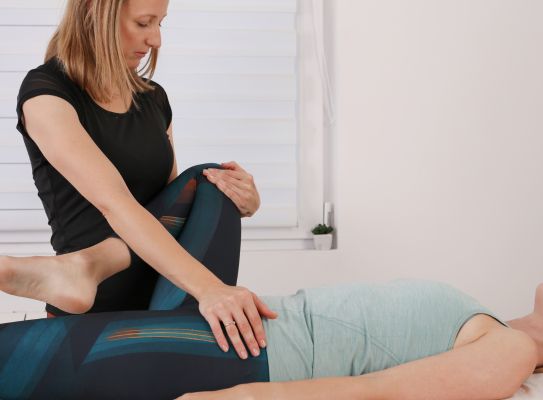Rehabilitation of Pelvic Floor Dysfunctions
What is Pelvic Floor Physio?
PHPT evaluates and addresses both internal and external pelvic floor muscles. Pelvic floor dysfunction manifests as either tightness or weakness in these muscles. The PHPT approach aims to enhance pelvic floor strength and promote optimal bowel and bladder function, leading to improved overall bodily comfort.
What Is Done In Pelvic Floor Physiotherapy?
The aim of Pelvic Floor Physiotherapy is to enhance pelvic floor function via exercises, lifestyle adjustments, education, and hands-on treatments to reduce and alleviate your symptoms. This therapy entails evaluating and addressing a set of muscles related to urinary, bowel, and sexual functions.
What Types Of Conditions Are Supported By Pelvic Floor Physiotherapy Treatments?

Pelvic floor therapy is applicable beyond women during pre- and post-pregnancy phases. Various dysfunctions and therapies exist for the pelvic floor, promoting overall well-being across all individuals.
- Improve Mobility & Spinal Health
Addressing posture, alleviating tension, and fostering overall bodily comfort.
- Urinary & Bowel Incontinence
Revitalize your body and regain control over incontinence with Pelvic Floor Physiotherapy, enhancing both control and confidence.
- Sexual Dysfunction
Rediscover intimacy and promote healing through physiotherapy: Empowering solutions for sexual wellness.
- Prostate Pain
Advanced solutions for prostate pain, customized to alleviate discomfort and enhance quality of life.
- Prenatal & Postnatal
Support the well-being of both the infant and the mother’s body during and post-pregnancy to promote optimal health.
- Hip Fractures & Joint Replacement
Specialized care is provided for hip fractures and joint replacements, aimed at facilitating optimal recovery and enhancing mobility.
How Do You Know If Your Pelvic Floor Is Tight Or Weak?
Stiff Hips:
For individuals experiencing tightness in the hips, discomfort when sitting cross-legged, or stiffness in one or both hips, it may be beneficial to have your pelvic floor assessed. The pelvic floor muscles play a role in hip rotation, and their relationship with hip rotators is significant. Recently, we encountered a patient with severe limitations in hip internal rotation. After addressing pelvic floor tension, she showed a 10-degree improvement in a single session. This correlation underscores the importance of considering factors beyond the pelvis in Pelvic Floor Physiotherapy.
Back pain:
This phenomenon is commonly observed among new parents but is applicable to individuals of any age or pregnancy status. Surprisingly, the pelvic floor is an integral component of the core, contributing to spinal stability. Weakness in the abdominal or back muscles can lead to increased demand on the pelvic floor. If persistent back pain persists with no effective Pelvic Floor Physiotherapy treatment, examining the pelvic region may be beneficial.
Jaw clenching:
During childbirth, women are commonly advised to relax their jaw while pushing, a practice that may resonate with individuals experiencing postpartum challenges. This advice stems from the intricate connection between the jaw and the pelvic floor. Due to embryological and fascial links, tension in one area can trigger tension in the other. This relationship explains the frequent occurrence of TMJ issues alongside pelvic pain. It is crucial for Pelvic Floor Physiotherapy to broaden their scope of assessment beyond the pelvic region, sometimes exploring areas far removed from it.
Constipation:
Your pelvic floor muscles envelop your rectum. When these muscles are tense or spasmed in this area, increased force may be required to pass stool, causing it to remain in the rectum for longer periods. Prolonged retention of stool in the rectum results in increased dryness and difficulty in evacuation. This cycle is commonly initiated by tension in the pelvic floor.
Pain with penetrative sex (vaginal or anal):
Just as with the rectum, the pelvic floor muscles envelop the vaginal canal. When these muscles are taut, they diminish the available space for penetration. This may lead individuals to perceive the opening as overly tight, experiencing sensations of tearing at the vaginal or anal opening, or even a deep, lingering ache. Such discomfort can arise during both initial and deeper penetration.
Tailbone pain:
One important aspect to understand about the tailbone is its capacity for movement. Additionally, it is crucial to note that the pelvic floor muscles are connected to the tailbone. Tight pelvic floor muscles on one side can lead to lateral displacement, causing discomfort. When both sides of the tailbone’s muscles are taut, it can result in anterior displacement, which is also painful. If you are experiencing tailbone discomfort, this would be the initial area to investigate.
Urinary urgency:
Urinary urgency is characterized by a sudden, intense need to urinate that may be challenging (or impossible) to manage. An underlying factor contributing to this condition is pelvic floor muscle tension. When the muscles enveloping the bladder and urethra are tense, shortened, or sensitive, they can disrupt bladder function as it fills. This disruption can result in bladder irritation, ultimately leading to urinary urgency.
Urinary frequency:
This concept is related to urinary urgency. When the muscles around the bladder constrain its capacity to fill, it triggers more frequent signals of needing to urinate compared to when filling is not restricted.
Pain with tampon insertion:
This is comparable to penetrative sex or gynecological exams; however, when using tampons, lubrication is usually even more minimal.
Urge incontinence:
Most individuals commonly associate incontinence with pelvic floor muscle weakness; however, tension can also play a significant role in contributing to leakage. Stress incontinence (leakage during activities like sneezing or jumping) is typically associated with weakness. On the other hand, urge incontinence (leakage due to the sudden urge to urinate) is often linked to pelvic floor tension. In reality, many individuals experience mixed incontinence, a condition combining elements of both weakness and tension in the pelvic floor muscles.
Vaginal or rectal pain:
One common indicator of pelvic floor tension is experiencing vaginal or rectal pain, after ruling out medical causes. Tight muscles, as in any part of the body, can lead to discomfort due to constant clenching. The pelvic floor, however, is unique as clenching often goes unnoticed until issues arise.

What Do You Use For Pelvic Floor Physiotherapy?
Techniques and Exercises For Pelvic Floor Physio
Pelvic Floor Physiotherapy may encompass various techniques and exercises such as:
- Trigger point therapy. This method applies pressure on specific areas of the body, known as trigger points, either internally or externally. Anesthesia may also be administered to the region by your physiotherapist.
- Kegels. Kegel exercises are a well-known method for strengthening pelvic floor muscles through contraction and relaxation. This exercise can aid in reducing discomfort during intercourse and managing incontinence. Our Pelvic Floor Physiotherapy team can provide guidance on performing Kegels effectively to maximize their benefits.
- Electrical stimulation. This technique aids in alleviating pelvic pain and muscle spasms. Our physiotherapist may perform this procedure at our Physiotherapy clinics in Surrey and Abbotsford or instruct you on how to do it at home using specialized equipment.
- Biofeedback. This approach involves utilizing devices to monitor the contraction of your pelvic floor muscles. Your physiotherapist will likely employ biofeedback to assess the progress of your exercises and monitor improvements. They may apply electrodes externally, positioned between the vagina or anus, or opt for an internal probe to gauge the tension and relaxation of your pelvic floor muscles. The outcomes are displayed on a computer screen, and our physiotherapist will review them with you.
The Best Pelvic Floor Physio in BCRevive Rehab: Multi-Disciplinary Support For Pelvic Floor Physio
When collaborating with Revive Rehab, you engage with a team that addresses your well-being holistically. Select from a range of supportive healing modalities.
Massage Therapy (RMT)
Registered Massage therapy can help alleviate tension, improve blood flow and circulation, reduce stress and promote relaxation in the body.
Acupuncture & Dry Needling
Utilize acupuncture or dry needling to target specific trigger points and address pain, tension and tightness in the pelvic floor region.
Chiropractic Care
Receive specialized Chiropractic Care adjustments to correct spinal misalignments that may be contributing to pelvic floor dysfunction.
Yoga & Pilates
Incorporate targeted stretches and exercises into your routine to improve flexibility, strengthen the pelvic floor muscles, and enhance overall body awareness.
Nutritional Counseling
Our team of physiotherapists can provide guidance on how certain foods and dietary changes may positively impact pelvic health and overall well-being.
Mental Health Support
Receiving therapy from a licensed mental health professional can help address any emotional or psychological factors that may be contributing to pelvic floor dysfunction.
Take charge of your wellness journey and explore the wide range of multi-disciplinary support options available through Revive Rehab. From advanced solutions for prostate pain, to specialized care for hip fractures and joint replacements, to holistic healing modalities such as massage therapy, acupuncture and yoga, our team is devoted to helping you achieve optimal pelvic health.
In addition to the above mentioned services, Revive Rehab also offers specialized treatment options for specific conditions such as urinary incontinence, pelvic organ prolapse, and vulvodynia. Our knowledgeable and experienced physiotherapists work together to create a personalized Pelvic Floor Physiotherapy treatment plan tailored to your individual needs and goals.
